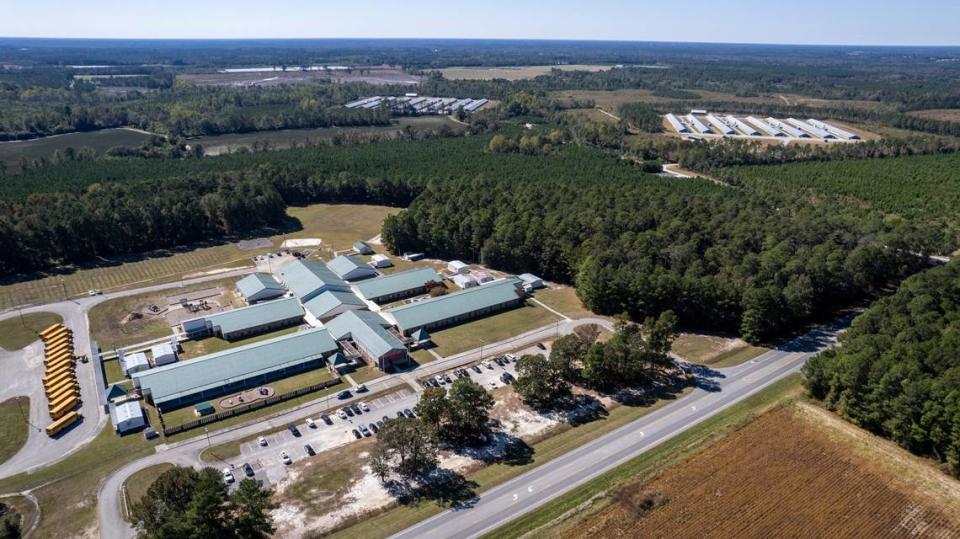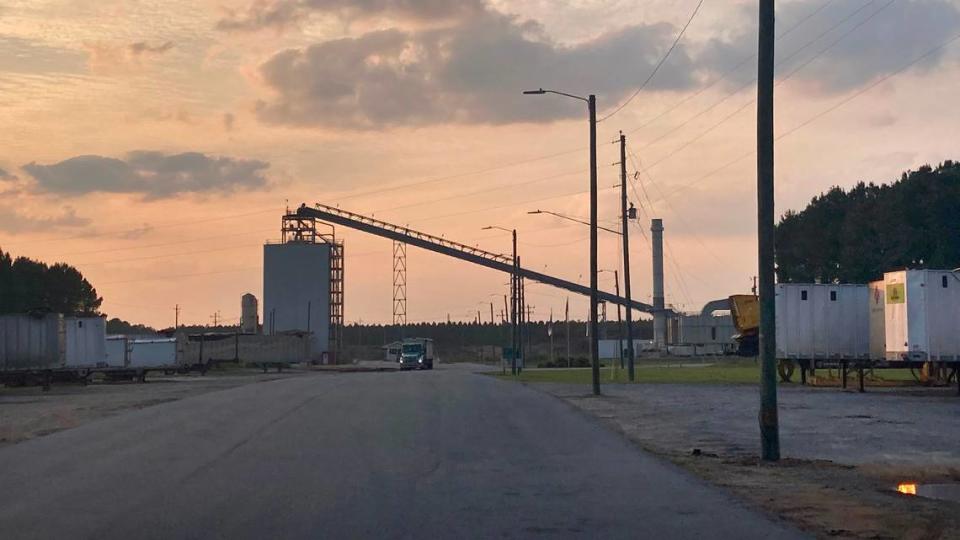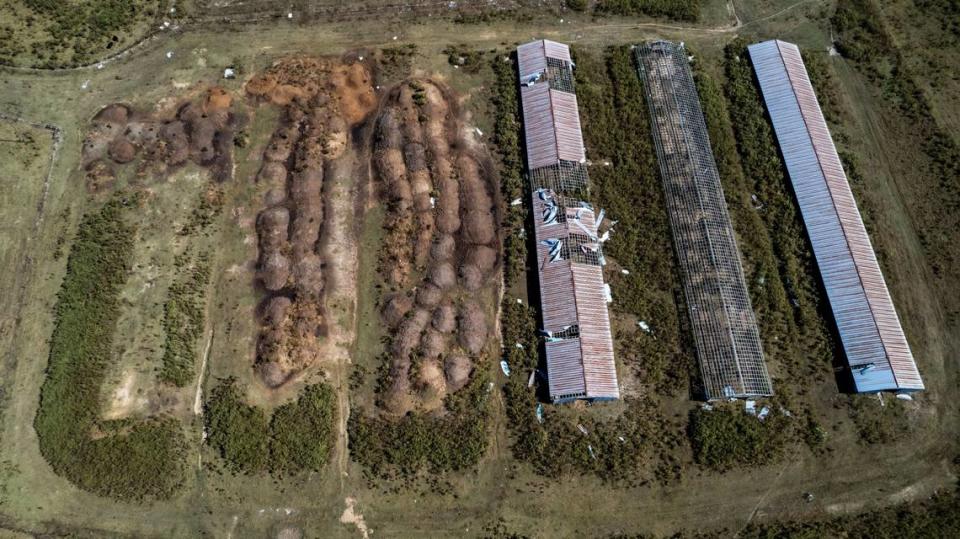Can NC regulators weigh existing pollution risks before allowing more? Some say yes.
Sherri White-Williamson started to fully understand how different sources of pollution can interact when she returned home to Sampson County in 2019.
After years living out of state, including a lengthy stint working for the EPA and then law school, she saw that the hog and poultry industries had spread across the rural county. On top of that, the state’s largest landfill had grown there and a wood pellet plant had opened just off of Interstate 40.
At the modest office suite where White-Williamson’s Environmental Justice Community Action Network is headquartered, it’s easy to smell the nearby Smithfield Fresh Meats Corp. processing plant, a strong odor of cooking pig.
“It can be pretty overwhelming at times. When you’re smelling all of that stuff in the air and then realizing that there’s some stuff you aren’t smelling that’s harmful, too, it is very concerning,” said White-Williamson, who also works as the N.C. Conservation Network’s director of environmental justice strategy.

White-Williamson chairs the cumulative impacts subcommittee of the Department of Environmental Quality’s Environmental Justice and Equity Advisory Board. That group is a focal point for much of the push by environmental advocates to push the regulatory agency to consider existing pollution in the vicinity when they evaluate environmental permit applications.
The subcommittee is in the midst of drafting recommendations that will urge DEQ to consider the combined effects of pollution and other burdens often carried by communities that have low incomes or high proportions of residents who are American Indian, Black or Hispanic. The environmental justice board may endorse them.
Whether DEQ will ever do so isn’t certain, however. DEQ officials argue that statutory changes are necessary for the agency to fully consider existing pollution when crafting permits, something the Republican leadership of the General Assembly has shown no sign of embracing.
But some environmental lawyers believe that authority already exists and the agency is simply unwilling to wield it.
No mandate or direction?
Environmental regulators’ path to approving an updated permit for Enviva’s wood pellet plant in Sampson County is indicative of DEQ’s process and where advocates believe it should be improved.

The agency is responsible for approving permits that limit the release of pollution to levels that have been approved by state and federal regulators. There are different sources of pollution, including air emissions, landfills and water discharges, among others.
DEQ’s standard approach to addressing cumulative pollution impacts in the vicinity of a facility applying for a new or revised environmental permit is evident across a number of recent permitting decisions.
Typically, the agency holds a public hearing for facilities that have a significant amount of public interest. Before that hearing, it makes documents available that describe what’s in the permit and what actions the company must take to limit pollution.
Sometimes this information includes what’s called an environmental justice analysis. It contains demographic characteristics of people living near a proposed facility, including data on age, disability rates, income and ethnic and racial makeup. The mapping analysis also shows what nearby facilities already hold DEQ permits.
In Sampson County, that analysis found a high proportion of Hispanic people live in the area immediately around the Enviva plant. Per capita income in that area was lower than Sampson and adjacent Duplin County averages.
At the October 19, 2021, public hearing, environmental advocates argued the permit could increase the pollution burden borne by the nearby community. Those focused on the 47.8 tons of tiny particulate matter that Enviva was proposing to release and how that could impact a nearby community already grappling with impacts from a dense concentration of hog and poultry farms.
Enviva maintains that it undergoes a “rigorous and thorough” permitting process despite not using chemicals as part of its process. The company takes trees and other biomass, dries them and then turns them into pellets for use as fuel in the United Kingdom and elsewhere.
“Each of our facilities has valid environmental permits and operates to comply well inside the U.S. federal and state regulatory emission standards, while maintaining rigorous monitoring, record-keeping, and reporting. In addition, our North Carolina facilities have undergone a full Environmental Justice review and assessment as part of the permitting process with NC DEQ,” an Enviva spokesman said in an email.
After a public hearing, a DEQ hearing officer assigned to the project reviews public comments and recommends what, if any, technical changes are necessary to the permit.
For the Sampson County project, the hearing officer concluded that disparities revealed by DEQ’s mapping exercise and the concerns expressed by advocates and residents weren’t enough. DEQ could not do anything to directly address adding to the pollution burden in considering the permit.
“While NCDEQ is committed to EJ [environmental justice] and equity, there is no authority that either mandates or directs NCDEQ to perform the more expansive type of cumulative impact analysis envisioned by the commenters,” wrote Melinda Wolanin, a DEQ engineer who was serving as the permit’s hearing officer.
The language Wolanin used is standard in DEQ hearing officer’s reports. It was also used in April 2022 to dismiss cumulative impact concerns raised about a power plant that wanted to burn poultry litter in Robeson County, also in eastern North Carolina.
This is a stance that bothers many people working in and studying environmental justice across the state who argue DEQ’s mapping efforts often show granting a permit will worsen pollution in communities that are already struggling. But they don’t affect permit decisions, they say.
“We continue to hear that DEQ’s hands are tied, they don’t have any grounds for denying the permit,” said Courtney Woods, a University of North Carolina-Chapel Hill environmental engineer.
“But it does beg the question: What role does that EJ report serve if there’s not going to be any sort of action, whether that’s denying the permit or requiring additional monitoring?” Woods continued. “It just feels like extra information that’s not being used.”
Lawyers say NC could do more
Some environmental lawyers argue that DEQ has the ability to consider cumulative impacts when making permitting decisions.
Will Hendrick, the NC Conservation Network’s environmental justice director, frequently speaks at public hearings and before DEQ advisory committee meetings, urging the agency to do more to curb exposure to pollution.
Speaking to DEQ’s Environmental Justice and Equity Advisory Board on May 4 about the upcoming review of general permits for hog, cattle and wet poultry operations, for instance, Hendrick said the advisory board should push the agency to incorporate cumulative impacts in its permit review.
“I encourage you to advise the consideration and response to cumulative impacts in communities hosting these operations, Hendrick said, adding: “There is ample time for the agency to determine what is to do about cumulative impacts borne by communities hosting CAFOs because these permits don’t expire until next September.”

At the heart of Hendrick’s argument is Title VI of the Civil Rights Act of 1964, which states that no agency that receives federal funding can discriminate against someone on the basis of that person’s race, color or national origin. The federal law also says a recipient of funds can be in violation by failing to take actions that protect those communities.
Hendrick points to N.C. General Statute 143-211(c), the place where North Carolina’s state laws define pollution control. There, the state laws describe an agency that will protect air and water while limiting pollution in order to protect human health, the environment and allow for economic opportunities.
The state law also says that the environmental agency must qualify to accept federal funding, meaning it would need to meet the requirements of federal civil rights law.
“That, to me, is all of the necessary reference to those federal obligations required in order for the agency to interpret its authority so as to enable action necessary to comply with federal nondiscrimination obligations,” Hendrick said.
A spokeswoman for DEQ, however, says state statute only requires a full cumulative impact assessment for landfills, as part of a 2007 law.
A separate statute requires that water permits undergo a cumulative impact assessment for other water pollution, but Hendrick notes that is focused on protecting the water itself rather than human health.
Ryke Longest, the director of Duke University’s Environmental Law and Policy Clinic, agrees with Hendrick. North Carolina’s state constitution references that the state has a responsibility to protect its air and water, Longest wrote in an email.
“These broad powers and the Constitutional mandate clearly show intention that NC DEQ is the guardian of the public trust over our air and water resources, not the cartel operator for pollution passes. NC DEQ has the power, even when they do not choose to use it,” Longest wrote.
Longest has concluded that a lack of financial resources at DEQ and fear of potential backlash from the General Assembly explains DEQ’s inaction in evaluating a full range of cumulative effects from pollution.
“DEQ has the power to consider these impacts, but frequently lacks the will to do so, even when required by statute,” Longest wrote.
Funding for this project comes from Kozik Environmental Justice Reporting Grants funded by the National Press Foundation and the National Press Club Journalism Institute. The News & Observer’s climate and environment reporting is produced with financial support from 1Earth Fund, in partnership with Journalism Funding Partners, as part of an independent journalism fellowship program. McClatchy maintains full editorial control of the work.

 Yahoo Sports
Yahoo Sports